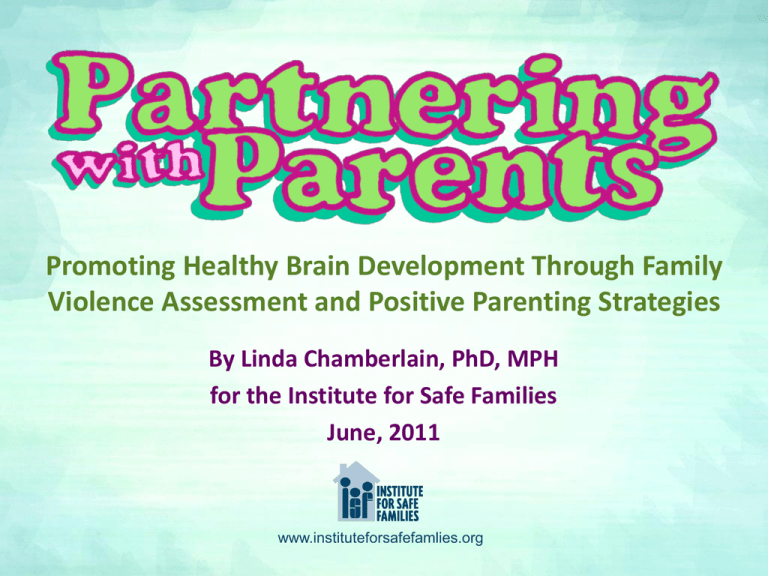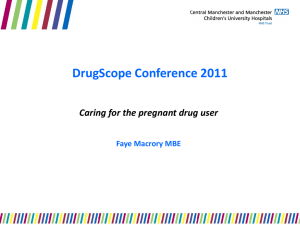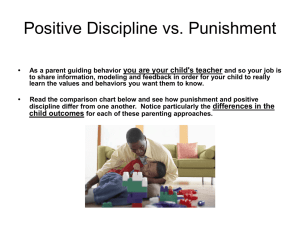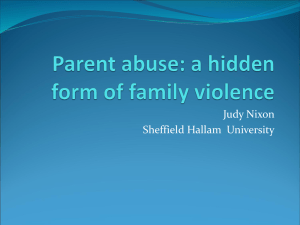Partnering with Parents (PwP)
advertisement

Promoting Healthy Brain Development Through Family Violence Assessment and Positive Parenting Strategies By Linda Chamberlain, PhD, MPH for the Institute for Safe Families June, 2011 www.instituteforsafefamlies.org Why We Developed the Partnering With Parents Toolkit • Scientific review of impact of childhood exposure to violence on early brain development • Raise awareness of harmful effects of physical punishment on children • Promote routine screening for domestic violence and physical punishment • Facilitate counseling/anticipatory guidance with parents for: -Early brain development -Prevent exposure to violence -Positive parenting and discipline The Amazing Brain 100 Billion Neurons Waiting to Connect…. Key Points Child’s environment and experiences shape early brain development Brain prioritizes survival first Exposure to violence can cause changes in brain development and function Anticipatory guidance should educate parents about healthy brain development and the impact of toxic developmental stressors Levels of Stress Moderate, short-lived stress responses that are normal part of life and healthy development. A child can learn to manage and control these experiences with support of caring adults in context of safe, warm, and positive relationships. Stress responses that could affect brain architecture but generally occur for briefer periods which allow brain to recover and thereby reverse potentially harmful effects. Strong, frequent or prolonged activation of body’s stress management system. Stressful events that are chronic, uncontrollable, and/or experienced without child having access to support from caring adults. National Scientific Council on the Developing Child, 2009 Toxic Developmental Stressors Child abuse and neglect Exposure to domestic violence Physical punishment Sequential Development of the Brain Abstract Thought Problem solving Affiliation Attachment Sexual Behavior Emotional Reactivity Motor Regulation Sleep Digestion Blood Pressure Heart Rate Respiration Body Temperature What are mirror neurons? Specialized nerve cells that perceive physical actions, facial expressions, and emotions to prepare brain to duplicate what it sees Capture adult’s emotions and create that same feeling in child What a parent does makes a much stronger impression on child than what they say Nelson, Erwin, & Duffy, 2007 Excessive Stress Disrupts Architecture of Child’s Developing Brain • Neural circuitry for dealing with stress is especially malleable during fetal and early childhood periods • Excessive stress programs hormone system toward exaggerated and prolonged response to stressors Bugental et al, 2003; National Council on the Developing Child, 2005; Teicher, 2011 Toxic Stress Can Affect Brain Development • Organizational changes • Brain chemistry imbalances • Structural changes Healthy Child Severe Emotional Neglect Centers for Disease Control and Prevention Neurobiological Effects of Witnessing Domestic Violence as Sole Stressor • Changes in inferior longitudinal fasciculus -Visual-limbic pathway for emotional, learning, and memory functions specific to vision • Thickness of cortex affected in several areas Teicher, 2010 Physical Punishment and the Developing Brain • In case-control study with non-clinical sample of young adults, harsh corporal punishment associated with reduced gray matter volume in prefrontal cortex Tomoda et al, 2009 Prefrontal Cortex Significant reduction in gray matter volume in right frontal gyrus (medial prefrontal cortex) in young adults exposed to harsh physical punishment during early childhood Tomoda et al, 2009 Behavioral, Mental, and Social Problems Associated with Traumatic Brain Development • Hypervigilance - “Always on the ready” Persistent physiological hyperarousal & hyperactivity More impulsive, aggressive behaviors Less able to tolerate stress Increased risk of physical and mental health problems Kuelbs, 2009; Perry, 2001; Shore, 2001; Teicher et al, 2002 Factors influencing child’s response to toxic stressors include: • • • • • • Age Genetics Length of exposure Severity of exposure Other adverse childhood experiences Protective factors Positive Parenting Promotes Healthy Brain Development Early, warm parental care (affection, acceptance, no slapping or spanking) is associated with brain maturation Rao et al, 2009 Dorothy Law Nolte Amazing Brain Series: Educational Resource for Parents • Designed to educate parents about early brain development, impact of trauma on early brain development, and how a child’s brain continues to change during adolescence Anticipatory Guidance with The Amazing Brain Booklets* 1. – – The Amazing Brain: What Every Parent/Caregiver Needs to Know Offers practical strategies to promote healthy brain development Use this resource to educate parents when talking about early childhood development 2. – The Amazing Brain: Trauma and the Potential for Healing Describes how exposure to violence impacts early brain development and what parents can do Use this resource when talking with parents about violence prevention – 3. – – The Amazing Teen Brain Describes changes occurring in adolescent brain and offer practical strategies for parenting teens Use this resource to talk with parents about communication, risk behaviors, and adolescent development * www.instituteforsafefamilies.org Physical Punishment Key Points Extensive research documenting that physical punishment is harmful to children Global movement in practices and policies prohibiting physical punishment Pediatric visits provide unique opportunity to educate parents about harmful effects of physical punishment and provide anticipatory guidance on effective discipline Definition Physical punishment is the use of physical force with the intention of causing a child to experience bodily pain or discomfort so as to correct or punish the child’s behavior Gershoff, 2008; Strauss, 2001 Status of U.S. Policies on Physical Punishment of Children • No federal or state laws prohibiting physical punishment in the home • 28 states and District of Columbia prohibit physical punishment in public schools • Legislation on use of physical punishment in other settings caring for children varies state to state Global Initiative to End Corporal Punishment of Children, 2010; Gershoff, 2008 AAP Statement on Spanking “The American Academy of Pediatrics strongly opposes striking a child for any reason. If a spanking is spontaneous, parents should later explain calmly why they did it, the behavior that provoked it, and how angry they felt. They also might apologize to their child for the loss of control. This usually helps the youngster to understand and accept the spanking, and it models for the child how to remediate a wrong.” AAP, 2009 How Common is Physical Punishment? Percentage Age of Child 17% of mothers spanked 6- to 13- month Previous week old infants Combs-Orme & Cain, 2008 26% of mothers spanked 3-year-olds Taylor et al, 2010 35% of parents physically punished 4- to 5-year olds Past week 80% of children By time they have been physically reach 5th grade punished Frequency/Time >2 times in previous month Lifetime Reference NLSY, 2002 Gershoff & Bitensky, 2007 Risk factors for physical punishment include: • • • • • • • • Maternal young age Single marital status Lower income and education attainment Large family size Maternal depression History of physical or sexual abuse Domestic violence Social or cultural expectation that spanking is part of parenting Chung, 2009; Combes-Orme, 2008; Dietz, 2000; Eamon, 2001; Gershoff, 2008; Regaldo et al, 2004; Straus, 1999; Wissow et al, 2001 Negative Consequences Children who experience physical punishment are at higher risk for: • • • • • • Behavioral problems and delinquent behaviors Low self-esteem Depression Substance abuse Poorer quality of relationship with parents Physical abuse of one’s own spouse and children as an adult Gershoff, 2008; Gershoff, 2002; Grogan-Kaylor et al, 2005; Mulvaney et al, 2007; Pardini et al, 2008; Slade et al, 2004; Straus, 1994 Spanking increases risk of physical aggression, anti-social behaviors, conduct problems and internalizing behaviors among children Grogan-Kaylor et al, 2005; Mulvaney et al, 2007; Pardini et al, 2008; Straus et al, 1996; Sugarman et al, 1997; Tremblay et al, 2004; Taylor et al, 2010* *These studies include longitudinal research with ethnically diverse national samples that controlled for other variables than could impact the study outcomes Addressing An Unmet Need • Nearly two-thirds (63.8%) of mothers said their doctor should talk with them about how their child behaves even if she was not worried about her child’s behavior (Busey et al, 2006) • But more than half of parents with children between 10- and 35- months of age said their pediatrician did not discuss discipline with them in past year (Olson et al, 2004) • Almost a third (30.9%) of parents interviewed in pediatric settings think their discipline strategy is ineffective (Barkin et al, 2007) Early Window of Opportunity for Prevention Mothers’ attitudes towards spanking when their infants were 6-months old were predictive of subsequent spanking of their young children Vittrup et al, 2006 Core of Pediatric Prevention: Anticipatory Guidance • Anticipatory guidance with parents improved discipline practices (Nelson, Wissow & Cheng, 2003) • Well-child visits provide opportunity to discuss how physical punishment can harm children and effective discipline strategies • Help parents to understand normal stages of development so they: – have realistic expectations for child’s behavior – know how to choose developmentally appropriate discipline strategies 3-Step Approach to Effective Discipline for Parents Establish positive and supportive relationship with your child Use positive reinforcement to increase behavior you want from your child If you need to discipline your child, do not spank or use physical punishment www.heatlthychilldren.org/English/family-life/family-dynamics/communication-discipline Five Building Blocks for Effective Discipline REINFORCE POSITIVE BEHAVIOR • “Catch” your child’s good behavior • Reward that behavior with praise, attention, or special activity •“I like how you shared your toy with your sister. Let’s read a story together.” SET UP AND ENFORCE LIMITS • Avoid ultimatums by setting limits and following them • “Josh, put away your toys, or you can’t help bake cookies today” TALK ABOUT IT • Explain why the behavior was inappropriate • Ask your child for suggestions so he/she can make a better choice next time MODEL GOOD BEHAVIOR • Help your partner or child with a task • Admit when you have made a mistake and apologize BE CONSISTENT • Follow through with consequences that you set ahead of time • Consistency does not mean being rigid • Adapt your parenting to your child and the situation Effective Parenting Strategies Age Range/Situation Children younger than 3 years old Children 3 years or older; especially when specific rule broken and when other discipline strategies have not worked All ages; for children younger than 6 or 7, best if done right away (not delayed until later in day) All ages; especially effective for whining, sulking, and pestering Strategy Description/Example Redirect, distract, supervise Help your child to focus on something else (different toy, activity); physically change or remove problem Time-out 1. Set rules ahead of time 2. Choose time-out spot 3. Set time limit (usually one minute for each year of child’s age) 4. Resume activity Withholding privileges Choose something that your child values but never something that your child truly needs (such as a meal) Active Ignoring Stop paying attention, offer alternative behavior, and give child attention when unwanted behavior stops/desired behavior adopted www.healthychild.org — www.zerotothree.org — www.stophitting.org Messages for Parents Every parent is doing the best they can Ask parents to think about the kind of parent they want to be Parenting is a process and every child is unique Violence---spanking, slapping, hurting---is never the answer The Amazing Brain and Discipline: Positive Parenting Builds Healthy Brains • Latest addition to “The Amazing Brain” Series • Use as part of anticipatory guidance to discuss child safety and discipline with parents • Provides six strategies for effective discipline within context of healthy brain development Evidence-based Practice: Safe Environment for Every Kid (SEEK) • Model care to prevent child maltreatment – Training for pediatric providers – Assessment with Parent Screening Questionnaire – Collaboration with social worker • Results of randomized controlled trial – Lower rates of child abuse and neglect – Less harsh punishment – Fewer delayed immunizations • Curriculum and parent handouts available Dubowitz et al, 2009 SEEK Parent Questionnaire Introduction: Being a parent is not easy. “We want to help families have a safe environment for kids. We are asking everyone these questions. Please answer questions about your child being seen today. They are about issues that affect many families. If there’s a problem, we’ll try to help.” Questions from SEEK questionnaire to ask about parenting: Do you sometimes find that you need to hit/spank your child? Do you often feel that your child is difficult to take care of? Evidence-based Cross-Cultural Resource: Play Nicely Program • Multimedia program teaches caregivers how to manage aggression in young children – Includes training track for health care providers • Developed by Dept. of Pediatrics at Vanderbilt University • 1-2 minute video clips shown during well-child visits • 90% of parents (49% were African American) said they would change how they discipline after viewing Play Nicely • Free for clinics www.childrenshospital.vanderbilt.org/interior.php?mid=1998 Promising Practices: This Hospital is a “NO HITTING ZONE” • Witnessing physical punishment is common in health care settings • Educational campaign to influence parental approaches to child discipline • Started at Rainbow Babies and Children’s Hospital, Cleveland, Ohio and replicated in other health care settings – Posters in patient rooms, bathrooms, elevators... – Brochures and handouts for parents – Educational sessions for clinical & support staff – Public service announcements Resources and Information • www.phoenixchildrens.com/community/injuryprevention-center/effective-discipline.html – Report on how physical punishment impacts children and parents’ brochure on effective discipline • www.stophitting.com – Data, policy updates, and strategies on how to advocate for ending physical punishment in homes and schools • www.onekindword.org – Information including employee training to raise awareness about parent-child conflicts in public & empower people to response supportively • www.healthychild.org – Articles and audios on effective discipline and communication • www.ciccparenting.org – Training and resources on culturally specific parenting Identifying and Responding to Exposure to Violence in the Pediatric Setting Key Points Childhood exposure to domestic violence is common Domestic violence, child abuse, and physical punishment are connected Childhood exposure to domestic violence leads to predictable physical, mental, cognitive and behavioral health problems Use Pediatric RADAR to identify and respond supportively to family violence Childhood Exposure to Domestic Violence is: Wide range of experiences for children whose caregivers are being physically, sexually, or emotionally abused. These experiences include: – observing caregiver being harmed, threatened, or murdered – overhearing these behaviors – being exposed to impact of physical, sexual and/or emotional abuse on caregiver Jaffe et al, 1990; McAlister, 2001 43 National Data • 1 out of 4 children exposed to at least one form of family violence during childhood – 6.6% exposed to domestic violence in past year • 7 to 15.5 million are exposed to domestic violence each year Finkelhor et al, 2009; McDonald et al, 2006 Role of the Pediatrician “Pediatricians are in a unique position to identify abused caregivers in the pediatric setting and to evaluate and treat children raised in homes in which intimate partner violence [domestic violence] occurs. Children exposed to intimate partner violence are at increased risk of being abused and neglected and are at more risk to develop adverse health, behavioral, psychological, and social disorders later in life. Identifying IPV, therefore, may be one of the most effective means of preventing child abuse…” American Academy of Pediatrics. Clinical Report—Intimate Partner Violence: Role of the Pediatrician. Pediatrics, 2010. Making the Connection Child Abuse Physical Punishment Domestic Violence Making the Connection • Domestic violence increases risk of physical punishment (Kelleher et al, 2008; Taylor et al, 2010) • The odds of physical child abuse is 2.7 times greater among mothers who spanked their children (Zolotor et al, 2008) • The risk of child abuse is 3 times higher in families with domestic violence (McGuigan & Pratt, 2001) • The more physical punishment a person experiences as a child, the more likely they are to be aggressive with their spouse (Cast et al, 2006) Mothers, DV, and Pregnancy Mothers experiencing domestic violence around time of pregnancy have lower maternal attachment with their infants Quinlivan & Evans, 2005 48 Exposure to domestic violence increases the likelihood of children experiencing: • • • • • Failure to thrive Bed wetting Speech disorders Vomiting and diarrhea Gastrointestinal problems • • • • Obesity Asthma Allergies Headaches Boynton-Jarrett et al, 2010; Campbell and Lewandowski, 1997; Graham-Bermann & Seng, 2005; Holt et al, 2008 73 Children whose mothers disclosed domestic violence are less likely to: Have the recommended 5 well child visits in first year of life Be fully immunized at 2 years of age Bair-Merritt et al, 2008 Children exposed to domestic violence are more likely to be diagnosed with: • • • • • Post-Traumatic Stress Disorder Depression Anxiety Developmental delays Internalizing and externalizing problems Edleson J, 1999; Graham-Bermann & Levendosky, 1998; Hurt et al, 2001; Lehmann, 2000; Martinez-Torteya et al, 2009; McCloskey & Walker; 2000; Spaccarelli et al, 1994; Wilden et al, 1991; Wolfe et al, 2003 51 Physical Punishment Increases Negative Impact of Domestic Violence Physical punishment increases risk of depression and internalizing and externalizing problems in children exposed to domestic violence Dorothy Law Nolte Hazen et al, 2006; Katz & Low, 2004; Morrell et al, 2003 Assessment is Intervention Abused women who talked with their health care provider about the abuse they experienced were: Nearly 4 times (OR=3.9) more likely to use an intervention 2.6 times more likely to leave the abusive relationship McCloskey et al, 2006 R = Routinely Screen Mothers for Abuse A = Are You Being Hurt? D = Document Your Findings A = Assess Safety of Mother and Children R = Respond, Review options & Refer www.instituteforsafefamilies.org R = Routinely Screen Mothers for Abuse • Asking about abuse and offering information has been shown to help mothers & children • Mothers support being asked about abuse during pediatric visits • Addressing abuse is a key strategy for preventing child abuse • Opportunity to ask mothers about the use of physical punishment as a discipline strategy and how her relationship may impact her parenting A = Are You Being Hurt? • Always interview parent alone if child is age two or older • Discuss confidentiality and any relevant mandated reporting requirements prior to asking questions • Ask direct questions routinely as part of social history in context of safety & discipline • “The safety of moms can affect the health and safety of children, so I ask all of our moms these personal questions.” “Is there anyone who has physically or sexually hurt you or frightened you?” “Do you feel safe with your husband/boyfriend?” “How does your husband/boyfriend discipline your child(ren)?” For moms disclosing abuse: “How do you think the abuse in your relationship has affected your parenting?” “What do you do to help you and your children stay safe?” D = Document Your Findings • Document that RADAR screening was done in pediatric chart (“+”, “-”, “suspected”) • If Mother answers “yes:” – Encourage her to talk about it and ask how you can help – Listen non-judgmentally and validate her experience: “You are not alone.” “Help is available.” – Offer referrals and resource information – Ask mother if it is safe to document her disclosure in the chart and use her words (“Karen Smith, the child’s mother, says that…” – Document referrals if it is safe to do so – If mandated reporting is required, involve mother in process A = Assess Safety of Mother and Children • Before she leaves the medical setting, ask if it is safe for her and her children to go home – Has the violence gotten worse? – Have there been threats of homicide or suicide? – Is there a gun or other weapon present? • Ask her if she would like to talk with a social worker or domestic violence advocate and work on a safety plan R = Respond, Review Options & Refer • Have a referral list that is routinely updated with in-house and local resources • Ask her if she has somewhere safe to go and someone to talk to • Offer hotline phone numbers and safety cards to take with her, if safe to do so, or write down numbers • Offer the use of private phone to talk with an advocate • Discuss how domestic violence affects children and whether the children need referrals Evidence-Based Interventions Child-Parent Psychotherapy (Lieberman et al, 2005; 2006) • Psycho-educational intervention for mothers & children • ↓ PTSD symptoms in child and mother and ↥ mother-child attachment & bonding Kids Club and Mom’s Empowerment (Graham-Bermann et al, 2007; 2010) • 10-week intervention with parenting support for mothers and group therapy for children • 77% reduction in internalizing behaviors and 79% reduction in externalizing behaviors among children Web-based Resource: LEAP [Look to End Abuse Permanently] www.leapsf.org • Discusses role of pediatric provider in addressing domestic violence • On-line training, and clinical resources including: – Screening forms & healthy relationship checklists – Documentation and mandatory reporting – Safety planning and safety cards Best Practice Alert: Bayview Child Health Center • Dr. Nadine Burke, a pediatrician, expanded routine assessment to include questions for adverse childhood experiences (ACE) in child health center • “Multidisciplinary rounds” to discuss how ACE scores impact patients’ health • Created integrated primary care teams and network of services to address early trauma Tough, 2011 Dr. Nadine Burke Take Home Messages! Exposure to violence affects early brain development and leads to changes in function, structure, and stress response. Physical punishment is a form of childhood exposure to violence that increases risk of adverse outcomes for children. Pediatric visits are windows of opportunity to screen for domestic violence and physical punishment. Include content on early brain development, childhood exposure to violence, and positive parenting and discipline in anticipatory guidance with parents. Work with staff to utilize printed materials and web-based resources to facilitate parent education. Linda Chamberlain, PhD, MPH is a scientist, author, professor, dog musher, and founder of the Alaska Family Violence Prevention Project. Dr. Chamberlain is a nationally recognized keynote speaker and champion for health issues related to domestic violence, children exposed to violence, brain development and trauma, and the amazing adolescent brain. She is known for her abilities to translate science into practical information with diverse audiences and convey a message of hope and opportunity. She is author of numerous publications and domestic violence training resources, and is also the editor for the e-journal, Family Violence Prevention and Health Practice. www.drlindachamberlain.com The Institute for Safe Families is a non-profit organization located in Philadelphia that is dedicated to family violence prevention. In addition to providing training and education for providers, ISF is an incubator for new ideas and brings emerging research into direct practice. ISF also convenes forums for cross-systems dialogue and promotes public awareness about the devastating effects of violence on children and families, using carefully designed materials, trainings, and creative technology. www.instituteforsafefamilies.org Partnering with Parents is made possible by a grant from the Barra Foundation. Additional support comes from The CHG Charitable Trust and The Thomas Scattergood Behavioral Health Foundation.









